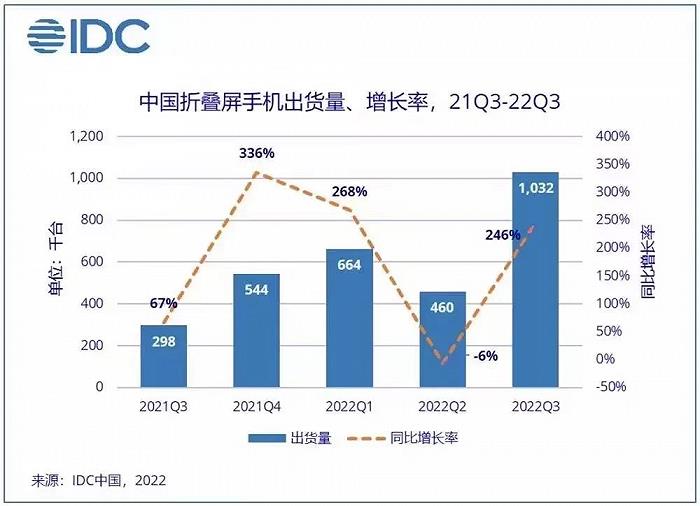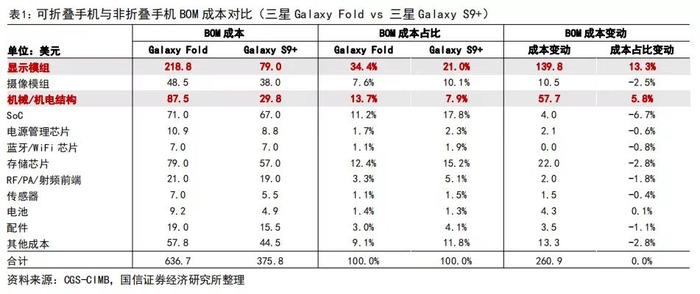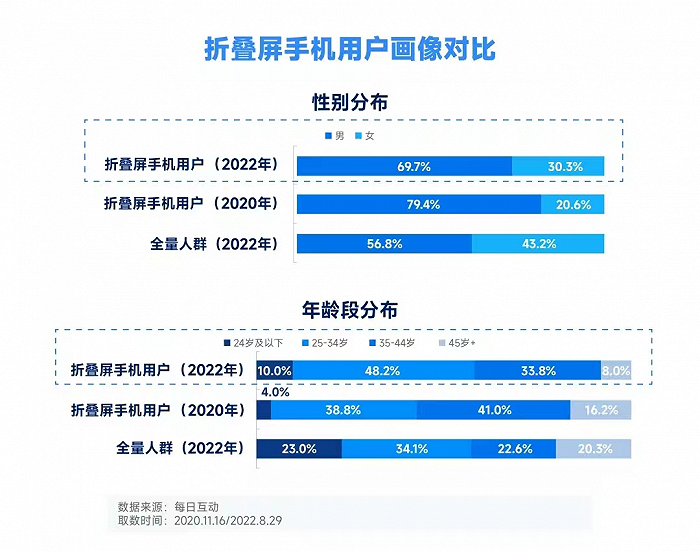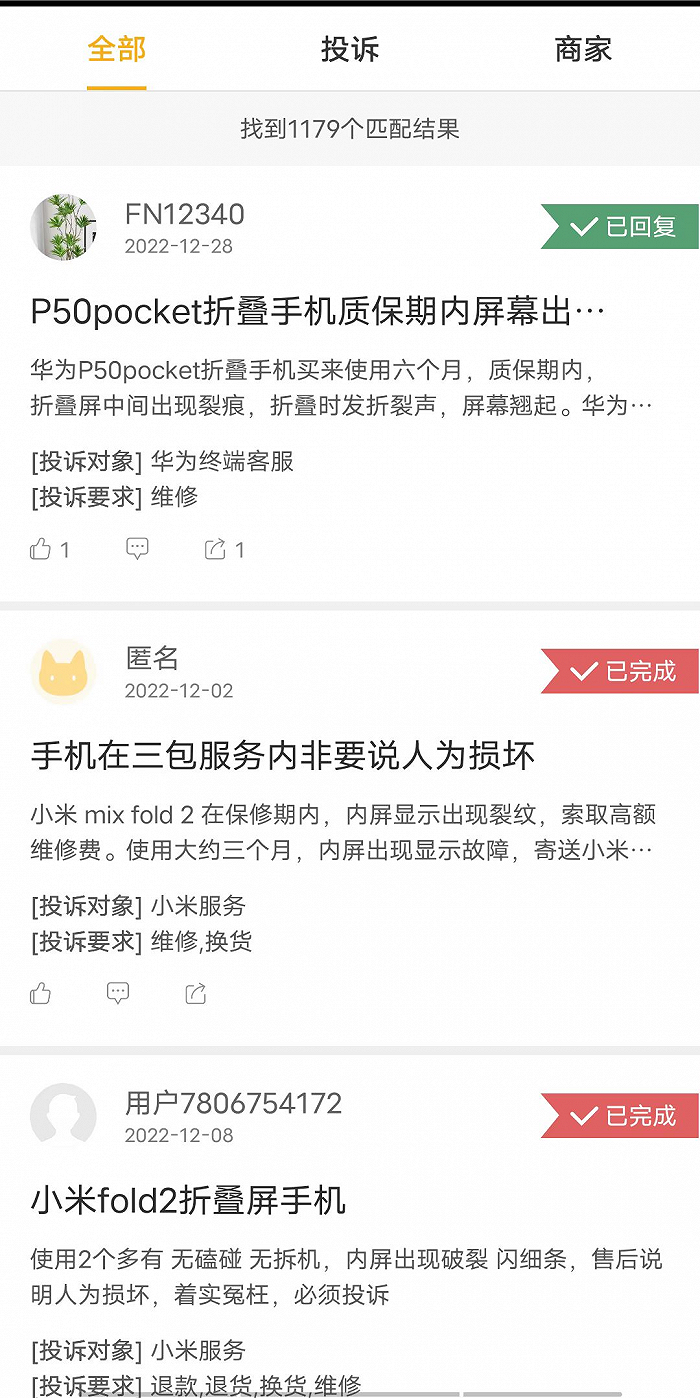Text | Deep Eyes Finance Zhang Wei
The folding screen caught fire in 2022 and the fire spread all the way to 2023.
The title of "the first year of folding screen" was born in 2022, one of the reasons is the high growth of folding screen shipments in 2022. According to IDC data, in the third quarter, China shipped more than 1 million folding screens, up about 246% year-on-year.

More importantly, this transcript of the folding screen was achieved in an environment of overall decline in smartphone shipments. According to the consulting data of Ai Media, the overall shipment volume of China mobile phone market will drop from 560 million in 2016 to 310 million in 2020. In 2021, mobile phone shipments rebounded slightly, but the overall environment is still not optimistic, with an annual shipment of only 350 million units.
It is not only the China market that participates in this folding screen carnival. According to Counterpoint research report, it is estimated that the global folding screen mobile phone market will increase by 52% year-on-year in 2023, reaching 22.7 million units.
You know, since the birth of the folding screen mobile phone, it has always been a niche track because of its relatively small market share, average sales volume and general market response.
When it was launched in the early years, it was also vomited by users because of the high price, obvious screen creases and heavy weight. Then, why did the folding screen, which was not welcomed by capital and market before, grow against the trend this year?
1. Capital betting, folding screen to become a new story?
Behind the fierceness of folding screen mobile phones is the embarrassment that mobile phone manufacturers urgently need to grow.
In the downturn of consumer market, the butterfly effect of mobile phone consumers is triggered: consumers who have no money in their belts naturally reduce their demand for mobile phones, and their replacement rate drops, which leads to a downward trend in mobile phone shipments. From January to November 2022, the total shipments of mobile phones in the domestic market totaled 244 million units, down 20.2% year-on-year.
In this context, as a relatively new product form, folding screen has become a "life-saving straw" in the mobile phone industry, and major mobile phone manufacturers have taken this opportunity to get involved in folding screen mobile phones.
At present, almost all mainstream mobile phone manufacturers have released new folding screen mobile phones, including Huawei’s Pocket S, Samsung’s Galaxy Z Flip4, OPPO’s Find N, Xiaomi’s Mix Fold2, VIVO’s X Fold+, etc., and the competition is fierce.
In 2022, Samsung, Huawei, OPPO, VIVO, Xiaomi and other mobile phone manufacturers released more than 10 folding screen mobile phones. According to the current news, there will be many new folding screen machines released in 2023, and even Apple has rumors that it will release folding screen smart phones in 2023.
In the past, high-end machines competed for chips, image capabilities, screen refresh rates, etc. Now, due to the involvement of smartphones in the Red Sea, technologies have entered a mature stage, and these technologies have been decentralized to low-end machines.
Although mobile phone manufacturers bet on the folding screen market, the herd effect is not fully applicable to consumers. In the era of information explosion, consumers are no longer the lambs to be slaughtered who are completely obedient to others.
On the one hand, from the perspective of mobile phone form, the design of folding screen is more futuristic. Compared with the previous folding screen mobile phones, the subdivision of scenes is one of the factors contributing to the growth of folding screen mobile phones, which means that folding screen mobile phones can radiate a wider range of people, and their product design, size, thickness and operation are different from business scenes, car scenes and game fields.
For example, OPPO Find N2 has not only paid attention to the internal and external screens, but also started to cut into the half-folded hovering, so that the mobile phone has a natural bracket, which brings more brand-new experiences to users from entertainment, and is more abundant in watching videos, photography and other leisure games.
Another example is Huawei’s main "folding screen meta-universe", which starts from smart life and exerts its strength on the external screen, and can obtain the weather, payment, camera, application and other dynamics without unfolding the screen. It can be said that the segmentation scene of the folding screen has jointly contributed to the shipment.
At the same time, the product forms of horizontal folding inner screen, horizontal folding outer screen and vertical folding screen also meet the habits and preferences of different people.
On the other hand, high-end is the only way for most industries to mature, and the mobile phone industry is no exception. According to relevant data, the average selling price of mobile phones in China market has increased from 1500-2000 yuan to 3000 yuan. The sales volume is falling, the average selling price is rising, and high-end mobile phones are increasingly favored by consumers.
In order to enhance the competitiveness of products, mobile phone companies are gradually abandoning the original sea tactics and moving towards the "fine machine" mode. According to the data released by China Xintong Institute, from January to October 2022, there were 308 new models on domestic brands, down 10% year-on-year.
The folding screen just meets the needs of users’ high-end machines. However, compared with the "puffy" folding screen four years ago, the folding screen now is more "material".
Previous folding screens always revolved around two problems: poor quality and high price. The report on the development trend of GFK China Folding Screen Smartphone released in 2022 shows that weight and price are still the core issues that prevent users from buying folding phones.
At the same time, according to the survey data of Ai Media Consulting, nearly 80% of the interviewed users buy folding screen mobile phones for entertainment needs, and the reason why the interviewed users don’t buy folding screen mobile phones is that they are expensive, accounting for 59.5%.
Under the focus of mobile phone manufacturers, according to the folding screen mobile phones recently launched by mobile phone manufacturers, today’s folding screen mobile phones are lighter, cheaper and have stronger endurance. For example, on December 25th, OPPO released the new folding screen flagship machine-—OPPO Find N2, which weighs only 233g and costs less than 9000 yuan.
Like the flagship machine Pocket S launched by Huawei, the weight is controlled at 190 grams while maintaining the screen size; Samsung Galaxy Z Fold4 is only 263 grams; Xiaomi’s MIX Fold weighs only 262 grams. Nowadays, almost all folding screens have controlled the weight below 300 grams, which makes it more convenient for users to use.
The price problem doesn’t stop there, and the price will remain downward. According to the Counterpoint research report, in view of the increasingly fierce competition in the folding screen smartphone market, it is expected that its price will be more close to the people in 2023. It can be said that the folding screen mobile phone confirms its "worth" step by step.
2. Self-developed core parts, "cost reduction" achieved initial results.
In order to change the status quo and make the folding screen realize another spring in the mobile phone industry, mobile phone manufacturers choose to break through from the upstream of the industrial chain.
Previously, in the folding screen mobile phone industry, Samsung not only dominated the industry, but also controlled the main components. According to Fomalhaut Techno Solution in the report, Huawei folding mobile phones Mate Xs and Xiaomi Mix Fold both use flexible screens made by Samsung, and Korean parts account for about 30% ~ 50% of the total.
According to the Monitoring Report of Folding Screen Mobile Phone Industry in China in 2022, the quality problem is the biggest concern for users to buy folding screens. Among the quality problems concerned by consumers, the crease of mobile phone is the most concerned, and hinge technology is the key to the crease problem.
And the main cost of folding screen mobile phone is 69% higher than that of non-folding mobile phone, of which the main cost comes from hinge and screen. According to the data of CGS—CIMB, the BOM cost of Galaxy Fold, Samsung’s first-generation folding screen mobile phone, was 636.7 USD, of which the display module cost was 218.8 USD, accounting for 34.4%, and the mechanical/electromechanical structure cost was 87.5 USD, accounting for 13.7%.
The display module cost of Samsung’s bar phone Galaxy S9+ accounts for 21%, and the mechanical/electromechanical structure cost accounts for 7.9%. From the perspective of BOM cost, screens and hinges are the main sources of the increase in the cost of folding screens.

In order to eliminate "bad reviews" and prevent key parts such as hinges and flexible screens from getting stuck in the neck, China brand has been gradually realized.Domestic substitution. The data shows that the number of patent applications related to folding screen hinge technology in China is on the rise, and the number of patent applications related to folding screen hinge in China is 160 in 2020.
At present, independent research and development of hinge technology has gradually become the core solution of mainstream terminal factories. According to the incomplete statistics of the potential silver optical chain, the hinge technology of various terminal factories has been constantly breaking through and innovating with the release of products, such as the aerospace-grade floating silver hinge of VIVO and the double-rotating eagle wing hinge of Huawei.
On the other hand, the folding screen mobile phone on the market has been optimized from 100,000 times in the early stage to 400,000 times, which is obviously improved.
According to the forecast of relevant industry organizations, the global hinge market for folding screen mobile phones will be 1.267 billion yuan in 2021, and it is expected to increase by 136.8% year-on-year to 2.999 billion yuan in 2022, which shows that hinge technology is the focus of the current breakthrough of folding screen.
Moreover, the domestic upstream display industry has achieved breakthroughs in technology, manufacturing and market, and domestic panel manufacturers such as BOE, Shentianma, TCL Huaxing and Visionox have accelerated the innovation and mass production of flexible screens. According to Omdia data, the global OLED production capacity is expected to increase from 31.51 million square meters in 2021 to 75 million square meters in 2027.
Including the optimization of appearance, Samsung has weakened the width of the hinge and the black edge of the screen, accounting for the external screen of the Galaxy Z Fold.
Judging from the recently released new products, the functions of folding screen mobile phones have become more and more perfect, such as the newly released X Fold+ of VIVO, which continues the characteristics of VIVO bar mobile phones, focusing on battery life and fast charging functions. Similarly, the latest Find N2 released by OPPO also has the function of improving endurance and satisfying fast charging.
3. Has the problem of folding screen been solved?
The folding screen mobile phone market has maintained growth for several consecutive quarters, and the growth rate in the third quarter of this year has also reached a new high. In the forecasts of various institutions, the folding screen market is expected to grow significantly.
So, can this situation be maintained, and who is buying a folding screen mobile phone?
The market is inseparable from the word supply and demand. If there is supply, there will be demand.

From the demand side, users as a whole are younger. The data shows that the young people under the age of 35 among the latest folding screen mobile phone users have increased significantly, accounting for 58.2%. Therefore, the supply and demand sides change rapidly in functions such as battery life and thinness.
In addition, according to the daily interactive big data, users of folding screen mobile phones not only have high requirements for mobile phones, but also have certain pursuits for quality of life. For example, they love to use life sharing apps such as Little Red Book and Public Comment.
From the demand side, the folding screen mobile phone has gradually developed from the ready to the development stage. The oversized screen is no longer as "chicken ribs" as before, but has derived more entertainment, business and other performances in terms of user needs.
However, after a year of focus, have the problems of folding screen phones really been solved?
Of course not. In the process of development, any industry will inevitably encounter different problems.
Even though the folding screen market has maintained growth for several consecutive quarters, the reason for maintaining high growth lies more in the focus of mobile phone manufacturers and the small market scale.
On the whole, the optimization of folding screen market has achieved initial results, but the problem has not really been solved. Different from the big step forward of the industrial chain, the recognition degree of folding screen is still at a low level, whether from product design to personal experience.
Judging from the black cat complaint data, most complaints about folding screen mobile phones are still focused on screen quality.

At present, most social platforms are still full of spit on folding screen mobile phones, and some of the reasons for spit are still the problems that were spit out a few years ago, including but not limited to screen off-line, liquid leakage, black spots and so on.
The main frequency of the folding screen model is not as durable as that of the integrated model, and the damage degree is higher. What is more "fatal" is that the follow-up maintenance cost is also higher. Taking Samsung’s latest Z Flod4 as an example, the price of the inner screen+outer screen assembly has reached 4,460 yuan, even for the lower-priced Samsung ZFILIP 4, the assembly price of the inner and outer screens also needs 2,460 yuan.
In the solution to the screen, the practice of major mobile phone manufacturers is to launch a broken screen saver service. Like Huawei’s Pocket S and VIVO’s Fold+, the official broken screensaver price is as high as 1199. The broken screensaver is not only high in price, but also guaranteed for only one year, which invisibly increases the follow-up cost of consumers.
The development of folding screen is also in line with the "first cause effect". In the early stage of development, due to the product’s too small, high price, fragile screen and other problems, it brought a deep negative impression to consumers, which led to the difficulty of market education in the later stage and the low recognition of the product.
One of the key problems is that the crease of mobile phone has not been verified by the market.
Even with the rapid development of hinge technology, the current folding screen market is still in the development stage. The major mobile phone manufacturers have launched newly upgraded folding screen mobile phones for more than one year, while the average service life of a mobile phone is three years.
The screen material will accelerate the aging speed after being folded for a long time. Although official website publicizes that the current flexible screen can be folded for 500,000 times, it does not rule out the possibility that the screen will be folded because of repeated folding.
According to the observation of "Deep Eyes Finance", the folding screen mobile phone just changes the product form, its functional integrity is not as good as that of the straight smart phone, and the improved functions are basically corresponding to the straight smart phone.
The main highlights of folding screen are split screen and multi-video viewing, but these requirements are not just needed by users and are irreplaceable.
As a high-end series product that has been tempered in the market for four years, its underlying logic is undoubtedly to meet the premise that "the folding screen is indeed better than the ordinary straight mobile phone".
Compared with the straight mobile phone, the straight mobile phone with the same price is obviously better from the processor. For example, Huawei’s Pocket S is equipped with 4G Snapdragon 778 processor, and the price starts at 5988. The P50 released by Huawei last year was equipped with Snapdragon 888 processor, and the price was only 4,088 when it was released.
Hard power is important, and soft power is indispensable. On the whole, the folding screen mobile phone still has a large market space, but when imagining the future, we should also study how to meet the demand side and strive for a larger market share.